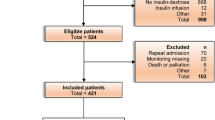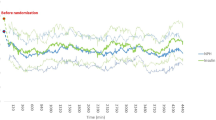Abstract
Hyperglycaemia during critical illness unequivocally correlates with adverse outcome. Three proof-of-concept randomized controlled trials have shown that preventing hyperglycaemia in patients admitted to the intensive care unit (ICU) reduces organ failure and mortality. A subsequent multicentre, randomized controlled trial found that targeting normoglycaemia in this patient population does not affect organ function differently than targeting an intermediate glucose level (7.8–10.0 mmol/l). However, an intermediate glucose target evoked less hypoglycaemia and, for currently unexplained reasons, also fewer deaths than a normoglycaemic target. Moreover, tolerating a caloric deficit, rather than providing nutrients parenterally, accelerated recovery from critical illness in the presence of normoglycaemia. Whether macronutrient restriction renders moderate hyperglycaemia less harmful remains to be investigated. Hence, if adequate monitoring tools and expertise are available, normoglycaemia remains the only proven effective target for insulin treatment of hyperglycaemia in ICU patients. However, if these conditions are not fulfilled in clinical practice, is an intermediate target range preferable? In the absence of hard evidence, common sense supports such an intermediate blood glucose target.
This is a preview of subscription content, access via your institution
Access options
Subscribe to this journal
Receive 12 print issues and online access
$209.00 per year
only $17.42 per issue
Buy this article
- Purchase on Springer Link
- Instant access to full article PDF
Prices may be subject to local taxes which are calculated during checkout


Similar content being viewed by others
References
Van den Berghe, G. et al. Clinical review: Intensive insulin therapy in critically ill patients: NICE-SUGAR or Leuven blood glucose target? J. Clin. Endocrinol. Metab. 94, 3163–3170 (2009).
Kosiborod, M. et al. Glucose normalization and outcomes in patients with acute myocardial infarction. Arch. Intern. Med. 169, 438–446 (2009).
The Endocrine Society. The Endocrine Society statement to providers on the American College of Physicians guidelines on intensive insulin therapy [online], (2011).
American Diabetes Association. Executive summary: standards of medical care in diabetes—2011. Diabetes Care 34 (Suppl 1.), S4–S10 (2011).
Qaseem, A., Humphrey, L. L., Chou, R., Snow, V. & Shekelle, P. Clinical Guidelines Committee of the American College of Physicians. Use of intensive insulin therapy for the management of glycemic control in hospitalized patients: a clinical practice guideline from the American College of Physicians. Ann. Intern. Med. 154, 260–267 (2011).
Dellinger, R. P. et al. Surviving Sepsis Campaign: international guidelines for management of severe sepsis and septic shock: 2008. Crit. Care Med. 36, 296–327 (2008). Erratum in: Crit. Care Med. 36, 1394–1396 (2008).
Skyler, J. S. et al. Intensive glycemic control and the prevention of cardiovascular events: implications of the ACCORD, ADVANCE, and VA Diabetes Trials: a position statement of the American Diabetes Association and a Scientific Statement of the American College of Cardiology Foundation and the American Heart Association. J. Am. Coll. Cardiol. 53, 298–304 (2009).
Van den Berghe, G. et al. Intensive insulin therapy in the critically ill patients. N. Engl. J. Med. 345, 1359–1367 (2001).
Kreymann, K. G. et al. ESPEN guidelines on enteral nutrition: intensive care. Clin. Nutr. 25, 210–223 (2006).
Singer, P. et al. ESPEN guidelines on parenteral nutrition: intensive care. Clin. Nutr. 28, 387–400 (2009).
Van den Berghe, G. et al. Outcome benefit of intensive insulin therapy in the critically ill: Insulin dose versus glycemic control. Crit. Care Med. 31, 359–366 (2003).
Van den Berghe, G. et al. Intensive insulin therapy in mixed medical/surgical intensive care units: benefit versus harm. Diabetes 55, 3151–3159 (2006).
Ellger, B. et al. Survival benefits of intensive insulin therapy in critical illness: impact of maintaining normoglycaemia versus glycemia-independent actions of insulin. Diabetes 55, 1096–1105 (2006).
Van den Berghe, G. et al. Intensive insulin therapy in the medical ICU. N. Engl. J. Med. 354, 449–461 (2006).
Schetz, M., Vanhorebeek, I., Wouters, P. J., Wilmer, A. & Van den Berghe, G. Tight blood glucose control is renoprotective in critically ill patients. J. Am. Soc. Nephrol. 19, 571–578 (2008).
Vlasselaers, D. et al. Intensive insulin therapy for patients in paediatric intensive care: a prospective, randomized controlled study. Lancet 373, 547–556 (2009).
Furnary, A. P., Cheek, D. B., Holmes, S. C., Howell, W. L. & Kelly, S. P. Achieving tight glycemic control in the operating room: lessons learned from 12 years in the trenches of a paradigm shift in anesthetic care. Semin. Thorac. Cardiovasc. Surg. 18, 339–345 (2006).
Krinsley, J. S. Effect of an intensive glucose management protocol on the mortality of critically ill adult patients. Mayo Clin. Proc. 79, 992–1000 (2004). Erratum in: Mayo Clin. Proc. 80, 1101 (2005).
Reed, C. C. et al. Intensive insulin protocol improves glucose control and is associated with a reduction in intensive care unit mortality. J. Am. Coll. Surg. 204, 1048–1054; discussion 1054–1055 (2007).
Lecomte, P. et al. Tight perioperative glucose control is associated with a reduction in renal impairment and renal failure in non-diabetic cardiac surgical patients. Crit. Care 12, R154 (2008).
Finfer, S. et al. Intensive versus conventional glucose control in critically ill patients. N. Engl. J. Med. 360, 1283–1297 (2009).
Scott, M. G., Bruns, D. E., Boyd, J. C. & Sacks, D. B. Tight glucose control in the intensive care unit: are glucose meters up to the task? Clin. Chem. 55, 18–20 (2009).
Vlasselaers, D. et al. Blood glucose measurements in arterial blood of intensive care unit patients submitted to tight glycemic control: agreement between bedside tests. J. Diabetes Sci. Technol. 2, 932–938 (2008).
Egi, M., Finfer, S. & Bellomo, R. Glycemic control in the ICU. Chest 140, 212–220 (2011).
Cembrowski, G. S. et al. Could susceptibility to low hematocrit interference have compromised the results of the NICE-SUGAR trial? Clin. Chem. 56, 1193–1195 (2010).
Boyd, J. C. & Bruns, D. E. Monte Carlo simulation in establishing analytical requirements for clinical laboratory tests: meeting the clinical needs. Methods Enzymol. 467, 411–433 (2009).
Karon, B. S., Boyd, J. C. & Klee, G. G. Glucose meter performance criteria for tight glycemic control estimated by simulation modeling. Clin. Chem. 56, 1091–1097 (2010).
Kanji, S. et al. Reliability of point-of-care testing for glucose measurement in critically ill adults. Crit. Care Med. 33, 2778–2785 (2005).
Villet, S. et al. Negative impact of hypocaloric feeding and energy balance on clinical outcome in ICU patients. Clin. Nutr. 24, 502–509 (2005).
Martindale, R. G. et al. Guidelines for the provision and assessment of nutrition support therapy in the adult critically ill patient: Society of Critical Medicine and American Society for Parenteral and Enteral Nutrition: Executive Summary. Crit. Care Med. 37, 1757–1761 (2009).
Heyland, D. K., Dhaliwal, R., Drover, J. W., Gramlich, L. & Dodek, P. Canadian clinical practice guidelines for nutrition support in mechanically ventilated, critically ill adult patients. J. Parenter. Enteral. Nutr. 27, 355–373 (2003).
Reid, C. Frequency of under- and overfeeding in mechanically ventilated ICU patients: causes and possible consequences. J. Hum. Nutr. Diet. 19, 13–22 (2006).
Dhaliwal, R., Jurewitsch, B., Harrietha, D. & Heyland, D. K. Combination enteral and parenteral nutrition in critically ill patients: harmful or beneficial? A systematic review of the evidence. Intensive Care Med. 30, 1666–1671 (2004).
Casaer, M. P. et al. Early versus late parenteral nutrition in critically ill adults. N. Engl. J. Med. 365, 506–517 (2011).
Vanhorebeek, I. et al. Protection of hepatocyte mitochondrial ultrastructure and function by strict blood glucose control with insulin in critically ill patients. Lancet 365, 53–59 (2005).
Langouche, L. et al. Intensive insulin therapy protects the endothelium of critically ill patients. J. Clin. Invest. 115, 2277–2286 (2005).
Van den Berghe, G., Schoonheydt, K., Becx, P., Bruyninckx, F. & Wouters, P. J. Insulin therapy protects the central and peripheral nervous system of intensive care patients. Neurology 64, 1348–1353 (2005).
Vanhorebeek, I. et al. Tissue-specific glucose toxicity induces mitochondrial damage in a burn injury model of critical illness. Crit. Care Med. 37, 1355–1364 (2009).
Vanhorebeek, I. et al. Hyperglycemic kidney damage in an animal model of prolonged critical illness. Kidney Int. 76, 512–520 (2009).
Van den Berghe, G. How does blood glucose control with insulin save lives in intensive care? J. Clin. Invest. 114, 1187–1195 (2004).
Langouche, L. et al. Effect of intensive insulin therapy on insulin sensitivity in the critically ill. J. Clin. Endocrinol. Metab. 92, 3890–3897 (2007).
Vanhorebeek, I. et al. Insufficient activation of autophagy allows cellular damage to accumulate in critically ill patients. J. Clin. Endocrinol. Metab. 96, E633–E645 (2011).
Rabinowitz, J. D. & White, E. Autophagy and metabolism. Science 330, 1344–1348 (2010).
Levine, B. & Kroemer, G. Autophagy in the pathogenesis of disease. Cell 132, 27–42 (2008).
Acknowledgements
The author's work is funded by the Methusalem program of the Flemish government (provided via Catholic University of Leuven).
Author information
Authors and Affiliations
Ethics declarations
Competing interests
The author declares an association with the following company: Baxter (grant/research support).
Rights and permissions
About this article
Cite this article
den Berghe, G. Intensive insulin therapy in the ICU—reconciling the evidence. Nat Rev Endocrinol 8, 374–378 (2012). https://doi.org/10.1038/nrendo.2012.14
Published:
Issue Date:
DOI: https://doi.org/10.1038/nrendo.2012.14
This article is cited by
-
Personalized nutrition approach in pediatrics: a narrative review
Pediatric Research (2021)
-
Effect of glycaemic control on complications following cardiac surgery: literature review
Journal of Cardiothoracic Surgery (2018)
-
Critical Care Management of Stress-Induced Hyperglycemia
Current Diabetes Reports (2018)
-
The intensive care medicine research agenda in nutrition and metabolism
Intensive Care Medicine (2017)
-
Continuous glucose monitoring on the ICU using a subcutaneous sensor
Medizinische Klinik - Intensivmedizin und Notfallmedizin (2015)



